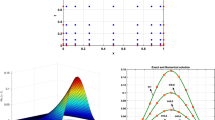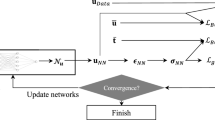Abstract
The accuracy and effectiveness of Hermite spectral methods for the numerical discretization of partial differential equations on unbounded domains are strongly affected by the amplitude of the Gaussian weight function employed to describe the approximation space. This is particularly true if the problem is under-resolved, i.e., there are no enough degrees of freedom. The issue becomes even more crucial when the equation under study is time-dependent, forcing in this way the choice of Hermite functions where the corresponding weight depends on time. In order to adapt dynamically the approximation space, it is here proposed an automatic decision-making process that relies on machine learning techniques, such as deep neural networks and support vector machines. The algorithm is numerically tested with success on a simple 1D problem, but the main goal is its exportability in the context of more serious applications. As a matter of fact we also show at the end an application in the framework of plasma physics.









Similar content being viewed by others
References
Bittencourt, J.A.: Fundamentals of Plasma Physics. Springer, New York (2004)
Camporeale, E., Delzanno, G.L., Lapenta, G., Daughton, W.: New approach for the study of linear Vlasov stability of inhomogeneous systems. Phys. Plasmas 13(9), 092110 (2006)
Chang, C.-C., Lin, C.-J.: LIBSVM: a library for support vector machines. ACM Trans. Intell. Syst. Technol. 2, 1–27 (2011)
Cybenko, G.: Approximation by superpositions of a sigmoidal function. Math. Control Signals Syst. 2, 303–314 (1989)
Delzanno, G.L.: Multi-dimensional, fully-implicit, spectral method for the Vlasov–Maxwell equations with exact conservation laws in discrete form. J. Comput. Phys. 301, 338–356 (2015)
Delzanno, G.L., Manzini, G., Pagliantini, C., Markidis, S.: Physics-based adaptivity of a spectral method for the Vlasov–Poisson equations based on the asymmetrically-weighted Hermite expansion in velocity space. Tech. Report (unpublished) LA-UR-19-29686, Los Alamos National Laboratory, Los Alamos, New Mexico, USA (2019)
Delzanno, G.L., Roytershtein, V.: Spectral approach to plasma kinetic simulation based on Hermite decomposition in velocity space. Front. Astron. Space Sci. (2018)
Drucker, H., Burges, C.J.C., Kaufman, L., Smola, A., Vapnik, V.: Support vector regression machines. Adv. Neural Inf. Process. Syst. 9, 11 (2003)
Fatone, L., Funaro, D., Manzini, G.: Arbitrary-order time-accurate semi-Lagrangian spectral approximations of the Vlasov–Poisson system. J. Comput. Phys. 384, 349–375 (2019)
Fatone, L., Funaro, D., Manzini, G.: A semi-Lagrangian spectral method for the Vlasov–Poisson system based on Fourier, Legendre and Hermite polynomials. Comm. Appl. Math. Comput. 1, 333–360 (2019)
Fatone, L., Funaro, D., Manzini, G.: On the use of Hermite functions for the Vlasov–Poisson system. In: Sherwin, S.J., Moxey, D., Peirã, J., Vincent, P.E., Schwab, C. (Eds.) Spectral and High Order Methods for Partial Differential Equations ICOSAHOM 2018. Lecture Notes in Computational Science and Engineering, vol. 134, pp. 143–153 (2020)
Funaro, D.: Polynomial Approximation of Differential Equations, vol. 8. Springer, Berlin (1992)
Funaro, D., Kavian, O.: Approximation of some diffusion evolution equations in unbounded domains by Hermite functions. Math. Comput. 57(196), 597–619 (1991)
Funaro, D., Manzini, G.: Stability and conservation properties of Hermite-based approximations of the Vlasov–Poisson system. J. Sci. Comput. 88, 29 (2021)
Gottlieb, D., Orszag, S.A.: Numerical analysis of spectral methods. Theory and applications. Society for Industrial and Applied Mathematics (1977)
Grad, H.: On the kinetic theory of rarefied gases. Commun. Pure Appl. Math. 2(4), 331–407 (1949)
Guo, B.-Y.: Error estimation of Hermite spectral method for nonlinear partial differential equations. Math. Comput. 68(227), 1067–1078 (1999)
Guyon, I., Boser, B., Vapnik, V.: Automatic capacity tuning of very large VC-dimension classifiers. In: Cowan, J.D., Hanson, S.J., Giles, C.L. (Eds.) Advances in Neural Information Processing Systems, pp. 147–155. Morgan Kaufmann (1993)
Hofmann, T., Schölkopf, B., Smola, A.J.: Kernel methods in machine learning. Ann. Stat. 36, 1171–1220 (2008)
Hu, Z., Cai, Z., Wang, Y.: Numerical simulation of microflows using Hermite spectral methods. SIAM J. Sci. Comput. 42, B105–B134 (2020)
Jin, X., Cai, S., Li, H., Karniadakis, G.E.: NSFnets (Navier–Stokes flow nets): physics-informed neural networks for the incompressible Navier–Stokes equations. J. Comput. Phys. 66, 109951 (2020)
Karniadakis, G.E., Hesthaven, J.: Machine learning for physical systems (special issue). J. Comput. Phys. 6, 66 (2019)
Kelley, C.T.: Iterative Methods for Optimization. SIAM, Philadelphia (1999)
Kharazmi, E., Zhang, Z., Karniadakis, G.E.: Variational physics-informed neural networks for solving partial differential equations (2019). arXiv:1912.00873
Luo, X., Yau, S.-T., Yau, S.S.-T.: Time-dependent Hermite–Galerkin spectral method and its applications. Appl. Math. Comput. 264(C), 378–391 (2015)
Ma, H., Sun, W., Tang, T.: Hermite spectral methods with a time-dependent scaling for parabolic equations in unbounded domains. SIAM J. Numer. Anal. 43(1), 58–75 (2005)
Manzini, G., Delzanno, G.L., Vencels, J., Markidis, S.: A Legendre–Fourier spectral method with exact conservation laws for the Vlasov–Poisson system. J. Comput. Phys. 317, 82–107 (2016)
Manzini, G., Funaro, D., Delzanno, G.L.: Convergence of spectral discretizations of the Vlasov–Poisson system. SIAM J. Numer. Anal. 55(5), 2312–2335 (2017)
Nguyen-Thien, T., Tran-Cong, T.: Approximation of functions and their derivatives: a neural network implementation with applications. Appl. Math. Model. 23, 687–704 (1999)
Pang, G., D’Elia, M., Parks, M., Karniadakis, G.E.: nPINNs: nonlocal physics-informed neural networks for a parametrized nonlocal universal Laplacian operator. Algorithms and applications. J. Comput. Phys. 66, 109760 (2020)
Pinkus, A.: Approximation theory of the MLP model in neural networks. Acta Numer. 8, 143–195 (1999)
Raissi, M., Perdikaris, P., Karniadakis, G.E.: Physics-informed neural networks: a deep learning framework for solving forward and inverse problems involving nonlinear partial differential equations. J. Comput. Phys. 378(1), 686–707 (2019)
Ramuhalli, P., Udpa, L., Udpa, S.S.: Finite-element neural networks for solving differential equations. IEEE Trans. Neural Netw. 16, 1381–1392 (2005)
Schölkopf, B., Burges, C., Vapnik, V.: Incorporating invariances in support vector learning machines. In: von der Malsburg, C., von Seelen, W., Vorbrüggen, J.C., Sendhoff, B. (eds.) Artificial Neural Networks ICANN-96. Lecture Notes in Computer Science, vol. 1112, pp. 47–52. Springer, Berlin (1996)
Schölkopf, B., Smola, A.J.: Learning with Kernels: Support Vector Machines, Regularization, Optimization and Beyond. Adaptive Computation and Machine Learning. MIT Press, Cambridge (2009)
Schumer, J.W., Holloway, J.P.: Vlasov simulations using velocity-scaled Hermite representations. J. Comput. Phys. 144(2), 626–661 (1998)
Shen, J., Tang, T., Wang, L.-L.: Spectral Methods: Algorithms, Analysis and Applications, 1st edn. Springer, Berlin (2011)
Shin, Y., Darbon, J., Karniadakis, G.E.: On the convergence of physics informed neural networks for linear second-order elliptic and parabolic type pdes. Commun. Comput. Phys. 28(5), 2042–2074 (2020)
Sirignano, J., Spiliopoulos, K.: DGM: a deep learning algorithm for solving partial differential equations. J. Comput. Phys. 66, 1339–1364 (2018)
Smola, A.J., Schölkopf, B.: A tutorial on support vector regression. Stat. Comput. 14, 199–222 (2004)
Stoffel, M., Bamer, F., Markert, B.: Artificial neural networks and intelligent finite elements in non-linear structural mechanics. Thin-Walled Struct. 131, 102–106 (2018)
Suykens, J.A.K., Vandewalle, J.: Least squares support vector machine classifiers. Neural Process. Lett. 9, 293–300 (1999)
Tang, T.: The Hermite spectral method for Gaussian-type functions. SIAM J. Sci. Comput. 14(3), 594–606 (1993)
Vapnik, V.: The support vector method of function estimation. In: Suykens, J.A.K., Vandewalle, J. (eds.) Nonlinear Modeling. Advanced Black–Box Techniques, Chapter 3, pp. 55–85. Springer, Berlin (1998)
Vapnik, V., Chervonenkis, A.Y.: On a class of perceptrons. Autom. Remote Control 25(1), 103–109 (1964)
Vapnik, V., Kotz, S.: Estimation of Dependences Based on Empirical Data. Springer Series in Statistics, 1st edn. Springer, Berlin (1982)
Vapnik, V., Lerner, A.: Pattern recognition using generalized portrait method. Autom. Remote Control 24, 774–780 (1963)
Vapnik, V.N.: The Nature of Statistical Learning Theory, 2nd edn. Springer, New York (2000)
Vencels, J., Delzanno, G.L., Manzini, G., Markidis, S., Bo Peng, I., Roytershteyn, V.: SpectralPlasmaSolver: a spectral code for multiscale simulations of collisionless, magnetized plasmas. J. Phys. Conf. Ser. 719(1), 012022 (2016)
Wang, T.-J., Zhang, C., Zhang, Q.: Mixed spectral method for heat transfer using generalised Hermite functions and Legendre polynomials. East Asian J. Appl. Math. 6, 448–465 (2016)
Yadav, Y., Yadav, A., Kumar, M.: An Introduction to Neural Network Methods for Differential Equations. Springer Briefs in Applied Sciences and Technology/Springer Briefs in Computational Intelligence, 1st edn. Springer, Berlin (2015)
Acknowledgements
The Authors are grateful to Dr. G. L. Delzanno (LANL) and Prof. C. Pagliantini for many fruitful discussions and suggestions. The Authors are affiliated to GNCS-INdAM (Italy). The third author was supported by the LDRD program of Los Alamos National Laboratory under Project Number 20170207ER. Los Alamos National Laboratory is operated by Triad National Security, LLC, for the National Nuclear Security Administration of U.S. Department of Energy (Contract No. 89233218CNA000001). This article is registered as LA-UR-21-22934.
Author information
Authors and Affiliations
Corresponding author
Additional information
Publisher's Note
Springer Nature remains neutral with regard to jurisdictional claims in published maps and institutional affiliations.
Appendix
Appendix
We begin by collecting some basic relations concerning Hermite polynomials. We denote with a prime the derivative of a given Hermite polynomial with respect to the argument \(\zeta \). Thus, the first and the second derivatives of the \(\ell \)-th Hermite polynomial, for \(\ell \ge 2\), are given by:
In addition, we have: \(H'_0(\zeta )=0, H'_1(\zeta )=2\), \(H''_0(\zeta )=0, H''_1(\zeta )=0\), so that (63) formally holds for any \(\ell \ge 0\). Useful recursive relations are:
For completeness, we note that for \(\ell =0\) it holds \(\zeta H_{0}(\zeta )=H_{1}(\zeta )/2\).
We now go through the computations relative to the three formulations (5), (15), (16). We start with the second one. We recall that \(\alpha \) depends on t and we denote by \(\alpha '\) its derivative. Concerning Hermite polynomials, the prime will continue to denote the derivative with respect to \(\zeta \). We substitute the definitions (11), (9) and we split the integral in three parts that will be computed separately:
To compute (I), we substitute \(\zeta =\alpha x\) and use the orthogonality properties of the Hermite polynomials to find that:
To compute the term (II), we substitute \(\zeta =\alpha x\) and use the orthogonality properties:
To compute term (III) we use (63) and the orthogonality of Hermite polynomials:
By collecting the results for \(\mathbf (I) , \mathbf (II) \), and \(\mathbf (III) \), we find out that:
In a similar fashion, we split the integral of the second derivative of \(u_N\) against the test function into three parts:
Using the properties of Hermite polynomials, we evaluate these terms as follows:
Putting all together we arrive at:
By equating (67) and (68) we finally obtain the scheme (14).
We then examine the scheme originating from (5). We must compute:
By changing the sign of the last term in (69) we exactly get the same result in (68) which brings again to the scheme (14).
We finally examine the scheme originating from (16). The first integral is clearly equal to \({{\widehat{u}}}_{m}(t)\). Successively, we evaluate:
Regarding the last integral, we split it into two parts:
These are finally evaluated as follows:
The final result of all these computations is again the scheme (14).
Rights and permissions
About this article
Cite this article
Fatone, L., Funaro, D. & Manzini, G. A Decision-Making Machine Learning Approach in Hermite Spectral Approximations of Partial Differential Equations. J Sci Comput 92, 3 (2022). https://doi.org/10.1007/s10915-022-01853-4
Received:
Revised:
Accepted:
Published:
DOI: https://doi.org/10.1007/s10915-022-01853-4
Keywords
- Time-dependent heat equation
- Generalized Hermite functions
- Machine learning
- Neural networks
- Support vector machine
- Spectral methods




